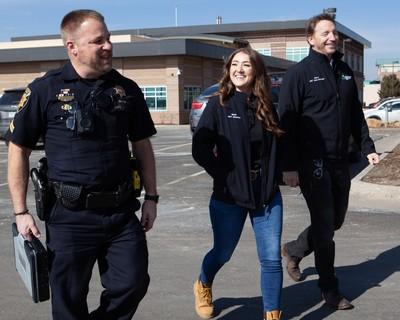Co-Responder programs
Co-Responder programs pair behavioral health specialists with law enforcement. These teams respond to police calls related to behavioral health. The team’s goal is to calm and de-escalate situations and connect individuals with necessary services.
Last updated: December 9, 2025
What are Co-Responder programs?
Co-Responder programs pair behavioral health specialists with law enforcement. These teams respond to police calls related to behavioral health. The team’s goal is to calm and de-escalate situations and connect individuals with necessary services.
Co-Responder programs are a model of criminal justice deflection. Deflection aims to turn people away from the criminal justice system. Another popular type of deflection program in Colorado is the Community Responder Programs. These programs have paramedics instead of police (for example, Denver STAR). While these two types of programs are similar, they are not the same. This page only discusses programs that pair behavioral health and law enforcement.
Supporting Coloradans experiencing crisis
Among more than 25,900 calls fielded by OBH-funded Co-Responder teams between July 2020 and June 2021, 98% avoided arrest, according to OBH data. In that same timeframe, Co-Responders provided some form of service to individuals on 86% of active calls, including behavioral health assessments and referrals to community resources. Read our Colorado Health Institute evaluation and this fact sheet for more information on call outcomes.
Read Testimonials from Police Departments and Sheriff's Offices

How Co-Responder programs work
Most teams have masters level clinicians on staff who specialize in crisis response. Often, this includes Licensed Clinical Social Workers or Licensed Professional Counselors. These clinicians are either employed by a community-based service provider contracted with the law enforcement agency or the city or county employs them directly.
Response Types
There are generally two approaches to how teams respond in the community:
- Primary Response: A team of officer(s) paired with behavioral health clinicians(s). The team rides together in the same vehicle for all or most of a shift. Some teams can also include paramedics in their response. The team generally responds only to calls related to behavioral health. The officer does not perform the regular duties of a patrol officer.
- Secondary Response: The behavioral health clinician responds separate from law enforcement. They receive response requests either by 911 dispatch or an officer. Once on scene, the behavioral health specialist handles the call with officer(s). Usually most or all officers on duty can request a response from the clinician.
What Co-Responder teams do
Once on scene, the team works to calm and de-escalate the situation. They also do crisis screening and assessments, to better understand the person's needs. Finally, they create a plan and give the person referrals or link them to needed services. There are a range of possible outcomes of a call. The person may get referrals and resources but stay where they are. The team may also transport them to a hospital or walk-in center. If family members or others are on scene, they may receive support and resources too.
Programs also follow up with individuals after they leave the initial encounter. This too can vary by program. Some programs follow up as a team. Other programs have dedicated case management services that follow up. Some programs also have peer support specialists who help engage people. Programs also work with other community resources to provide coordination and linkage with other systems of care.
Co-Responder programs also do cross-training between law enforcement and the behavioral health clinicians. Training can be both formal and informal. This cross-training generally leads to greater understanding and shifts in agency culture. Download Co-Responder outcomes.
How to request a Co-Responder team
Co-Responder programs' hours of operation can vary. Ask if there is a Co-Responder or a mental health team available if you call the police or 911 because of a crisis. If police are already there, ask the officer(s) if there is a Co-Responder or mental health team available to talk to.
Options if a Co-Responder team isn’t available
If a Co-Responder team isn’t available, your local police department may be able to send a Crisis Intervention Team (CIT) officer. These officers have been through a special 40 hour training to help respond to mental health calls. You can ask for a “CIT officer.” To learn more about CIT in Colorado, please visit their website.
If safety isn’t a concern or police aren’t otherwise needed, 988 is available 24 hours a day, 7 days per week. Please visit the 988 website to find out more about 988 and other crisis services in Colorado.
Co-Responder program funding
Since 2018, the State of Colorado has funded Co-Responder programs. As of July 1, 2025, BHA funds 30 programs across the state, with a total budget of $8.5 Million. Programs are funded in the following ways:
- Marijuana Tax Cash Fund (C.R.S. 39-28.8-501)
- SB17-207 authorized the development and implementation of eight new Co-Responder programs throughout Colorado.
- Allocated amount: $3.67 million per year
- In 2024 a Request for Proposals was released to distribute funds formerly referred to as Offender Behavioral Health Services to local governments to launch or continue programs that were previously funded through community service providers.
- Allocated amount: $3.1 million per year
- SB17-207 authorized the development and implementation of eight new Co-Responder programs throughout Colorado.
- State General Fund
- SB19-008 authorized the development and implementation of five new Co-Responder programs throughout Colorado.
- Allocated amount: $1.7 Million per year
- SB19-008 authorized the development and implementation of five new Co-Responder programs throughout Colorado.